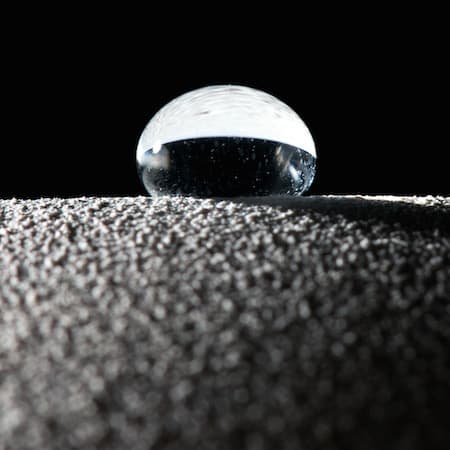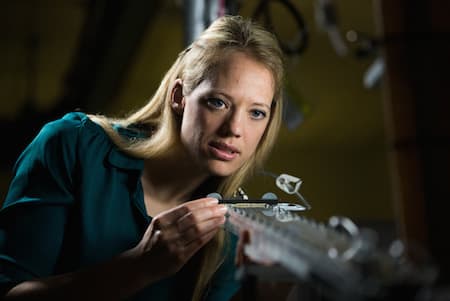Engineers At BYU Develop Super Waterproof Surfaces That Have Great Real-Life Applications
A team of mechanical engineering professors at the Brigham Young University have developed a super-hydrophobic (or waterproof) surface that is capable of bouncing the droplet of water like a ball off of it. The engineers - Julie Crockett and her colleague Dan Maynes have been working for years together to study the super-hydrophobic surfaces because of their capability to be used in an awesome range of real life applications. With the research work, they've been so far able to develop some commercial products such as a shoe-cleaner or a device that prevents oil from building up on bolts, the duo is looking forward to bringing large-scale solutions.
The newly designed super-hydrophobic surface consists of a sloped channel that is extremely difficult to wet. They have published a study in Physics of Fluids - an academic journal, that shows theses surfaces featuring a pattern of microscopic ridges or posts, combined with a hydrophobic coating. The results show that depending on how the water hits it, the surface has an unprecedentedly high level of water resistance.

To bring to your focus the importance of the research work regarding the super hydrophobic surfaces, let us breeze through the wide range of critical applications that they bring. To start with, we can have solar panels that never get dirty or have self-cleaning mechanism because of the water rolling off of them. Bio-medical devices such as tubes and syringes can be made super waterproof from the inside, so that they become safer in delivering fluids to patients. The hulls of ships and exterior of submarines can benefit a lot from being extremely resistant to water, as can showers tubs and toilets. Other than that, there's also the - airplane wings that will be able to resist wingtip icing in cold humid conditions
If that's not all, we'd love to present the applications this BYU mechanical engineers are aiming for. The researchers are working on facilitating cleaner and more efficient energy generation. All the major power plants across the world - burn coal or natural gas to create steam for rotating the turbine. This steam is later condensed back into a liquid state and thus recycled. If the optimal super-hydrophobic surface is used to build these condensers in power plants, the process can be made a lot faster and efficient when it comes to the cost spent. With the presence of the super-hydrophobic surface, the water will never be attracted to the condenser wall and therefore as the steam starts condensing to a liquid, the water just rolls right off.

The development method for creating these micro-structured surfaces is quite similar to photo film development that etches patterns onto CD-sized wafers. A thin water-resistant film (such as Teflon) is then added to the surfaces. Then comes the high-tech part - Ultra-high-speed cameras are used to document the way water interacts when dropped, jetted or boiled on them. To understand the process in depth, you can listen to Prof. Crockett talk about this project in detail in the following video -
What are your thoughts on the super-hydrophobic surfaces? Share with us in comments below.
The newly designed super-hydrophobic surface consists of a sloped channel that is extremely difficult to wet. They have published a study in Physics of Fluids - an academic journal, that shows theses surfaces featuring a pattern of microscopic ridges or posts, combined with a hydrophobic coating. The results show that depending on how the water hits it, the surface has an unprecedentedly high level of water resistance.

To bring to your focus the importance of the research work regarding the super hydrophobic surfaces, let us breeze through the wide range of critical applications that they bring. To start with, we can have solar panels that never get dirty or have self-cleaning mechanism because of the water rolling off of them. Bio-medical devices such as tubes and syringes can be made super waterproof from the inside, so that they become safer in delivering fluids to patients. The hulls of ships and exterior of submarines can benefit a lot from being extremely resistant to water, as can showers tubs and toilets. Other than that, there's also the - airplane wings that will be able to resist wingtip icing in cold humid conditions
If that's not all, we'd love to present the applications this BYU mechanical engineers are aiming for. The researchers are working on facilitating cleaner and more efficient energy generation. All the major power plants across the world - burn coal or natural gas to create steam for rotating the turbine. This steam is later condensed back into a liquid state and thus recycled. If the optimal super-hydrophobic surface is used to build these condensers in power plants, the process can be made a lot faster and efficient when it comes to the cost spent. With the presence of the super-hydrophobic surface, the water will never be attracted to the condenser wall and therefore as the steam starts condensing to a liquid, the water just rolls right off.

The development method for creating these micro-structured surfaces is quite similar to photo film development that etches patterns onto CD-sized wafers. A thin water-resistant film (such as Teflon) is then added to the surfaces. Then comes the high-tech part - Ultra-high-speed cameras are used to document the way water interacts when dropped, jetted or boiled on them. To understand the process in depth, you can listen to Prof. Crockett talk about this project in detail in the following video -
Source: #-Link-Snipped-#
0
